Polylactide (PLA) and Its Blends with Poly(butylene succinate) (PBS): A Brief Review
Abstract
1. Introduction
2. Structure and Properties of Neat Polymer PLA and PBS
2.1. Building Blocks and Synthesis
2.2. Polymer Properties
3. Toughness Modification
3.1. Simple Blending
3.2. Plasticization
3.3. Reactive Compatibilization
3.4. Copolymerization
3.5. Discussion of Toughness Modification
4. Crystallization Modification
4.1. Effect of Poly(butylene succinate)
4.2. Effect of Stereocomplexation
4.3. Effect of Nucleation
4.4. Effect of Processing Parameters
4.5. Discussion of the Crystallization Modification
5. Degradation
5.1. Standards for Biodegradation and Disintegration of Plastics
5.2. Influencing Factors and Degradation Mechanisms
5.3. Biodegradation and Disintegradation of PLA/PBS Blends
6. Recycling
7. Application
8. Conclusions
Author Contributions
Funding
Acknowledgments
Conflicts of Interest
References
- United Nations. About the Sustainable Development Goals. Available online: //www.un.org/sustainabledevelopment/sustainable-development-goals/ (accessed on 15 April 2019).
- The RTO Innovation Summit. Impact through Research: Applied Research for Europe’s Future. Available online: https://www.fraunhofer.de/en/press/research-news/2018/november/the-rto-summit.html (accessed on 8 July 2019).
- European Bioplastics. Plastics Strategy—Contribution of Bioplastics to a Sustainable Circular Plastics Economy; European Bioplastics e.V.: Berlin, Germany, 2018. [Google Scholar]
- European Bioplastics. Bioplastics Market Data. Available online: https://www.european-bioplastics.org/market/ (accessed on 12 February 2019).
- Wang, L.; Ma, W.; Gross, R.A.; McCarthy, S.P. Reactive compatibilization of biodegradable blends of poly(lactic acid) and poly(ε-caprolactone). Polym. Degrad. Stab. 1998, 59, 161–168. [Google Scholar] [CrossRef]
- Sheth, M.; Kumar, R.A.; Davé, V.; Gross, R.A.; Mccarthy, S.P. Biodegradable polymer blends of poly(lactic acid) and poly(ethylene glycol). J. Appl. Polym. Sci. 1997, 66, 1495–1505. [Google Scholar] [CrossRef]
- Zhao, P.; Liu, W.; Wu, Q.; Ren, J. Preparation, Mechanical, and Thermal Properties of Biodegradable Polyesters/Poly(Lactic Acid) Blends. J. Nanomater. 2010, 2010, 1–8. [Google Scholar] [CrossRef]
- Jiang, L.; Wolcott, M.; Zhang, J. Study of biodegradable polylactide/poly/butylene adipate-co-terephthalate) blends. Biomacromolecules 2006, 9, 199–207. [Google Scholar] [CrossRef] [PubMed]
- Bhatia, A.; Gupta, R.; Bhattacharya, S.; Choi, H. Compatibility of biodegradable poly (lactic acid) (PLA) and poly (butylene succinate) (PBS) blends for packaging application. Korea-Aust. Rhelogy J. 2007, 19, 125–131. [Google Scholar]
- Gigli, M.; Fabbri, M.; Lotti, N.; Gamberini, R.; Rimini, B.; Munari, A. Poly(butylene succinate)-based polyesters for biomedical applications: A review. Eur. Polym. J. 2016, 75, 431–460. [Google Scholar] [CrossRef]
- Changwichan, K.; Silalertruksa, T.; Gheewala, S. Eco-Efficiency Assessment of Bioplastics Production Systems and End-of-Life Options. Sustainability 2018, 10, 952. [Google Scholar] [CrossRef]
- Hamad, K.; Kaseem, M.; Ayyoob, M.; Joo, J.; Deri, F. Polylactic acid blends: The future of green, light and tough. Prog. Polym. Sci. 2018, 85, 83–127. [Google Scholar] [CrossRef]
- Novamont. Mater-Biotech: Inaugurated the World First Plant for the Production of Bio-Butanediol from Renewable Resources. Available online: https://www.novamont.com/eng/read-news/mater-biotech/ (accessed on 8 July 2019).
- D’Ambrosio, R.; Michell, R.; Mincheva, R.; Hernández, R.; Mijangos, C.; Dubois, P.; Müller, A. Crystallization and Stereocomplexation of PLA-mb-PBS Multi-Block Copolymers. Polymers 2018, 10, 8. [Google Scholar] [CrossRef]
- Ikada, Y.; Jamshidi, K.; Tsuji, H.; Hyon, S.H. Stereocomplex formation between enantiomeric poly(lactides). Macromolecules 1987, 20, 904–906. [Google Scholar] [CrossRef]
- Wang, R.; Wang, S.; Zhang, Y.; Wan, C.; Ma, P. Toughening modification of PLLA/PBS blends via in situ compatibilization. Polym. Eng. Sci. 2009, 49, 26–33. [Google Scholar] [CrossRef]
- Mallegni, N.; Phuong, T.V.; Coltelli, M.-B.; Cinelli, P.; Lazzeri, A. Poly(lactic acid) (PLA) Based Tear Resistant and Biodegradable Flexible Films by Blown Film Extrusion. Materials 2018, 11, 148. [Google Scholar] [CrossRef] [PubMed]
- Zhang, K.; Mohanty, A.K.; Misra, M. Fully biodegradable and biorenewable ternary blends from polylactide, poly(3-hydroxybutyrate-co-hydroxyvalerate) and poly(butylene succinate) with balanced properties. ACS Appl. Mater. Interfaces 2012, 4, 3091–3101. [Google Scholar] [CrossRef] [PubMed]
- Weise, B.; Huysman, S.; Manvi, P.; Theunissen, L. PBS-based Fibres for Renewable Textiles. Bioplatics Mag. 2018, 05, 24–25. [Google Scholar]
- Xu, J.; Guo, B.-H. Poly(butylene succinate) and its copolymers: Research, development and industrialization. Biotechnol. J. 2010, 5, 1149–1163. [Google Scholar] [CrossRef] [PubMed]
- Farah, S.; Anderson, D.G.; Langer, R. Physical and mechanical properties of PLA, and their functions in widespread applications—A comprehensive review. Adv. Drug Deliv. Rev. 2016, 107, 367–392. [Google Scholar] [CrossRef]
- Yokohara, T.; Yamaguchi, M. Structure and properties for biomass-based polyester blends of PLA and PBS. Eur. Polym. J. 2008, 44, 677–685. [Google Scholar] [CrossRef]
- Supthanyakul, R.; Kaabbuathong, N.; Chirachanchai, S. Random poly(butylene succinate-co-lactic acid) as a multi-functional additive for miscibility, toughness, and clarity of PLA/PBS blends. Polymer 2016, 105, 1–9. [Google Scholar] [CrossRef]
- Chaiwutthinan, P.; Pimpan, V.; Chuayjuljit, S.; Leejarkpai, T. Biodegradable Plastics Prepared from Poly(lactic acid), Poly(butylene succinate) and Microcrystalline Cellulose Extracted from Waste-Cotton Fabric with a Chain Extender. J. Polym. Environ. 2015, 23, 114–125. [Google Scholar] [CrossRef]
- Park, J.W.; Im, S.S. Phase behavior and morphology in blends of poly(l-lactic acid) and poly(butylene succinate). J. Appl. Polym. Sci. 2002, 86, 647–655. [Google Scholar] [CrossRef]
- Park, S.B.; Hwang, S.Y.; Moon, C.W.; Im, S.S.; Yoo, E.S. Plasticizer effect of novel PBS ionomer in PLA/PBS ionomer blends. Macromol. Res. 2010, 18, 463–471. [Google Scholar] [CrossRef]
- Kfoury, G.; Raquez, J.-M.; Hassouna, F.; Odent, J.; Toniazzo, V.; Ruch, D.; Dubois, P. Recent advances in high performance poly(lactide): From “green” plasticization to super-tough materials via (reactive) compounding. Front. Chem. 2013, 1, 32. [Google Scholar] [CrossRef] [PubMed]
- Imre, B.; Pukánszky, B. Compatibilization in bio-based and biodegradable polymer blends. Eur. Polym. J. 2013, 49, 1215–1233. [Google Scholar] [CrossRef]
- Hansen, C.M. Hansen Solubility Parameters. A User’s Handbook, 2nd ed.; CRC Press: Boca Raton, FL, USA, 2007; ISBN 0849372488. [Google Scholar]
- Abbott, S. Chemical compatibility of poly(lactic acid): A practical framework using hansen solubility parameters. In Poly(Lactic Acid): Synthesis, Structures, Properties, Processing, and Applications; Auras, R., Lim, L.-T., Selke, S.E.M., Tsuji, H., Eds.; John Wiley & Sons, Inc.: Hoboken, NJ, USA, 2010; ISBN 9780470649848. [Google Scholar]
- Ruellan, A.; Guinault, A.; Sollogoub, C.; Ducruet, V.; Domenek, S. Solubility factors as screening tools of biodegradable toughening agents of polylactide. J. Appl. Polym. Sci. 2015, 132. [Google Scholar] [CrossRef]
- Van Krevelen, D.W.; Nijenhuis, K.T. Properties of Polymers. Their Correlation with Chemical Structure Their Numerical Estimation and Prediction from Additive Group Contributions, 4th completely rev. ed.; Elsevier: Amsterdam, The Netherlands, 2009; ISBN 9780080548197. [Google Scholar]
- Valerio, O.; Misra, M.; Mohanty, A.K. Statistical design of sustainable thermoplastic blends of poly(glycerol succinate-co-maleate) (PGSMA), poly(lactic acid) (PLA) and poly(butylene succinate) (PBS). Polym. Test. 2018, 65, 420–428. [Google Scholar] [CrossRef]
- Robeson, L.M. Polymer Blends. A Comprehensive Review; Hanser Verlag: München, Germany, 2007; ISBN 9783446436503. [Google Scholar]
- Wang, Y.-P.; Xiao, Y.-J.; Duan, J.; Yang, J.-H.; Wang, Y.; Zhang, C.-L. Accelerated hydrolytic degradation of poly(lactic acid) achieved by adding poly(butylene succinate). Polym. Bull. 2016, 73, 1067–1083. [Google Scholar] [CrossRef]
- Pivsa-Art, W.; Fujii, K.; Nomura, K.; Aso, Y.; Ohara, H.; Yamane, H. The effect of poly(ethylene glycol) as plasticizer in blends of poly(lactic acid) and poly(butylene succinate). J. Appl. Polym. Sci. 2016, 133. [Google Scholar] [CrossRef]
- Supthanyakul, R.; Kaabbuathong, N.; Chirachanchai, S. Poly(l-lactide-b-butylene succinate-b-l-lactide) triblock copolymer: A multi-functional additive for PLA/PBS blend with a key performance on film clarity. Polym. Degrad. Stab. 2017, 142, 160–168. [Google Scholar] [CrossRef]
- Zhang, X.; Liu, Q.; Shi, J.; Ye, H.; Zhou, Q. Distinctive Tensile Properties of the Blends of Poly(l-lactic acid) (PLLA) and Poly(butylene succinate) (PBS). J. Polym. Environ. 2018, 26, 1737–1744. [Google Scholar] [CrossRef]
- Liu, X.; Dever, M.; Fair, N.; Benson, R.S. Thermal and Mechanical Properties of Poly(lactic Acid) and Poly(ethylene/butylene Succinate) blends. J. Polym. Environ. 1997, 5, 225–235. [Google Scholar]
- Vieira, M.G.A.; da Silva, M.A.; dos Santos, L.O.; Beppu, M.M. Natural-based plasticizers and biopolymer films: A review. Eur. Polym. J. 2011, 47, 254–263. [Google Scholar] [CrossRef]
- Fortunati, E.; Puglia, D.; Iannoni, A.; Terenzi, A.; Kenny, J.M.; Torre, L. Processing Conditions, Thermal and Mechanical Responses of Stretchable Poly (Lactic Acid)/Poly (Butylene Succinate) Films. Materials 2017, 10, 809. [Google Scholar] [CrossRef] [PubMed]
- Harada, M.; Ohya, T.; Iida, K.; Hayashi, H.; Hirano, K.; Fukuda, H. Increased impact strength of biodegradable poly(lactic acid)/poly(butylene succinate) blend composites by using isocyanate as a reactive processing agent. J. Appl. Polym. Sci. 2007, 106, 1813–1820. [Google Scholar] [CrossRef]
- Hu, X.; Su, T.; Li, P.; Wang, Z. Blending modification of PBS/PLA and its enzymatic degradation. Polym. Bull. 2018, 75, 533–546. [Google Scholar] [CrossRef]
- Srimalanon, P.; Prapagdee, B.; Markpin, T.; Sombatsompop, N. Effects of DCP as a free radical producer and HPQM as a biocide on the mechanical properties and antibacterial performance of in situ compatibilized PBS/PLA blends. Polym. Test. 2018, 67, 331–341. [Google Scholar] [CrossRef]
- Zhang, B.; Sun, B.; Bian, X.; Li, G.; Chen, X. High Melt Strength and High Toughness PLLA/PBS Blends by Copolymerization and in Situ Reactive Compatibilization. Ind. Eng. Chem. Res. 2017, 56, 52–62. [Google Scholar] [CrossRef]
- Li, L.; Song, G.; Tang, G. Novel Biodegradable Polylactide/Poly(butylene succinate) Composites via Cross-Linking with Methylene Diphenyl Diisocyanate. Polym.-Plast. Technol. Eng. 2013, 52, 1183–1187. [Google Scholar] [CrossRef]
- Chinda, C.; Hongsriphan, N. Ductility Enhancement of Poly(butylene succinate)/Poly(lactic acid) Blend by the Use of Glycidyl Methacrylate. Available online: https://www.researchgate.net/publication/328213636_Ductility_enhancement_of_polybutylene_succinatepolylactic_acid_blend_by_the_use_of_glycidyl_methacrylate (accessed on 15 March 2019).
- Ji, D.; Liu, Z.; Lan, X.; Wu, F.; Xie, B.; Yang, M. Morphology, rheology, crystallization behavior, and mechanical properties of poly(lactic acid)/poly(butylene succinate)/dicumyl peroxide reactive blends. J. Appl. Polym. Sci. 2014, 131. [Google Scholar] [CrossRef]
- Chen, G.-X.; Kim, H.-S.; Kim, E.-S.; Yoon, J.-S. Compatibilization-like effect of reactive organoclay on the poly(l-lactide)/poly(butylene succinate) blends. Polymer 2005, 46, 11829–11836. [Google Scholar] [CrossRef]
- Manning, S.C.; Moore, R.B. Reactive compatibilization of polypropylene and polymide-6,6 with carboxylated and maleated polypropylene. Polym. Eng. Sci. 1999, 39, 1921–1929. [Google Scholar] [CrossRef]
- Galeski, A.; Bartczak, Z.; Martuscelli, E. Nucleation process in thoughend plastics. In Advanced Routes for Polymer Toughening; Martuscelli, E., Musto, P., Ragosta, G., Eds.; Elsevier: Amsterdam, The Netherlands, 1996. [Google Scholar]
- Kim, Y.J.; Park, O.O. Miscibility and Biodegradability of Poly(Butylene Succinate)/Poly(Butylene Terephthalate) Blends. J. Polyers Environ. 1999, 7, 53–66. [Google Scholar] [CrossRef]
- Luzi, F.; Fortunati, E.; Jiménez, A.; Puglia, D.; Pezzolla, D.; Gigliotti, G.; Kenny, J.M.; Chiralt, A.; Torre, L. Production and characterization of PLA_PBS biodegradable blends reinforced with cellulose nanocrystals extracted from hemp fibres. Ind. Crop. Prod. 2016, 93, 276–289. [Google Scholar] [CrossRef]
- Pivsa-Art, W.; Fujii, K.; Nomura, K.; Aso, Y.; Ohara, H.; Yamane, H. Isothermal crystallization kinetics of talc-filled poly(lactic acid) and poly(butylene succinate) blends. J. Polym. Res. 2016, 23, 160. [Google Scholar] [CrossRef]
- Xu, H.; Teng, C.; Yu, M. Improvements of thermal property and crystallization behavior of PLLA based multiblock copolymer by forming stereocomplex with PDLA oligomer. Polymer 2006, 47, 3922–3928. [Google Scholar] [CrossRef]
- Jing, Z.; Shi, X.; Zhang, G.; Lei, R. Investigation of poly(lactide) stereocomplexation between linear poly(L-lactide) and PDLA-PEG-PDLA tri-block copolymer. Polym. Int. 2015, 64, 1399–1407. [Google Scholar] [CrossRef]
- Li, Z.; Tan, B.H.; Lin, T.; He, C. Recent advances in stereocomplexation of enantiomeric PLA-based copolymers and applications. Prog. Polym. Sci. 2016, 62, 22–72. [Google Scholar] [CrossRef]
- Zhang, X.; Meng, L.; Li, G.; Liang, N.; Zhang, J.; Zhu, Z.; Wang, R. Effect of nucleating agents on the crystallization behavior and heat resistance of poly(l-lactide). J. Appl. Polym. Sci. 2016, 133. [Google Scholar] [CrossRef]
- Mallet, B.; Lamnawar, K.; Maazouz, A. Improvement of blown film extrusion of poly(Lactic Acid): Structure-Processing-Properties relationships. Polym. Eng. Sci. 2014, 54, 840–857. [Google Scholar] [CrossRef]
- Osborn, K.R.; Jenkins, W.A. Plastic Films: Technology and Packaging Applications; CRC Press: Boca Raton, FL, USA, 1992. [Google Scholar]
- Communication from the Commission to the European Parliament, the Council, the European Economic and Social Committee and the Committee of the Regions: A European Strategy for Plastics in a Cicular Economy; European Commission: Brussels, Belgium, 2018.
- nova-Institute. Biodegradable, Bio-Based Polymers in Various Environments. Available online: http://bio-based.eu/downloads/biodegradable-bio-based-polymers-in-various-environments/ (accessed on 8 July 2019).
- Chinaglia, S.; Tosin, M.; Degli-Innocenti, F. Biodegradation rate of biodegradable plastics at molecular level. Polym. Degrad. Stab. 2018, 147, 237–244. [Google Scholar] [CrossRef]
- Mochizuki, M.; Hirami, M. Structural Effects on the Biodegradation of Aliphatic Polyesters. Polym. Adv. Technol. 1997, 8, 203–209. [Google Scholar] [CrossRef]
- La Mantia, F.P.; Morreale, M.; Botta, L.; Mistretta, M.C.; Ceraulo, M.; Scaffaro, R. Degradation of polymer blends: A brief review. Polym. Degrad. Stab. 2017, 145, 79–92. [Google Scholar] [CrossRef]
- Zhang, S.J.; Tang, Y.W.; Cheng, L.H. Biodegradation Behavior of PLA/PBS Blends. AMR 2013, 821–822, 937–940. [Google Scholar] [CrossRef]
- Fleischer, G.; Habashi, F.; Menges, G.; Bilitewski, B.; Loll, U. Waste, 5. Recycling. In Ullmann’s Encyclopedia of Industrial Chemistry; Wiley-VCH Verlag GmbH & Co. KGaA: Weinheim, Germany, 2011. [Google Scholar] [CrossRef]
- Tsuneizumi, Y.; Kuwahara, M.; Okamoto, K.; Matsumura, S. Chemical recycling of poly(lactic acid)-based polymer blends using environmentally benign catalysts. Polym. Degrad. Stab. 2010, 95, 1387–1393. [Google Scholar] [CrossRef]
- Bioplasticsmagazine. Bio-Based Polymers Have Potential in Biomedicine, Agricultural Markets. Available online: https://www.bioplasticsmagazine.com/en/news/meldungen/20150407-New-report-shows-promise-bioplastics.php (accessed on 8 July 2019).
- Soroudi, A.; Jakubowicz, I. Recycling of bioplastics, their blends and biocomposites: A review. Eur. Polym. J. 2013, 49, 2839–2858. [Google Scholar] [CrossRef]
- FKuR Kunststoff GmbH. Bio-Flex S 5630 WH; FKuR Kunststoff GmbH: Willich, Germany; Available online: https://fkur.com/en/brands/bio-flex-3/bio-flex-s-5630/ (accessed on 8 July 2019).
- nova-Institut GmbH. K 2010: FKuR Präsentiert neue Biokunststoffe für Folien- und Spritzgießanwendungen. Bio-Flex Compounds Erweitern das Nachhaltige Produkt-Portfolio der Kunststoff GmbH; nova-Institut GmbH: Hürth, Germany, 2010. [Google Scholar]



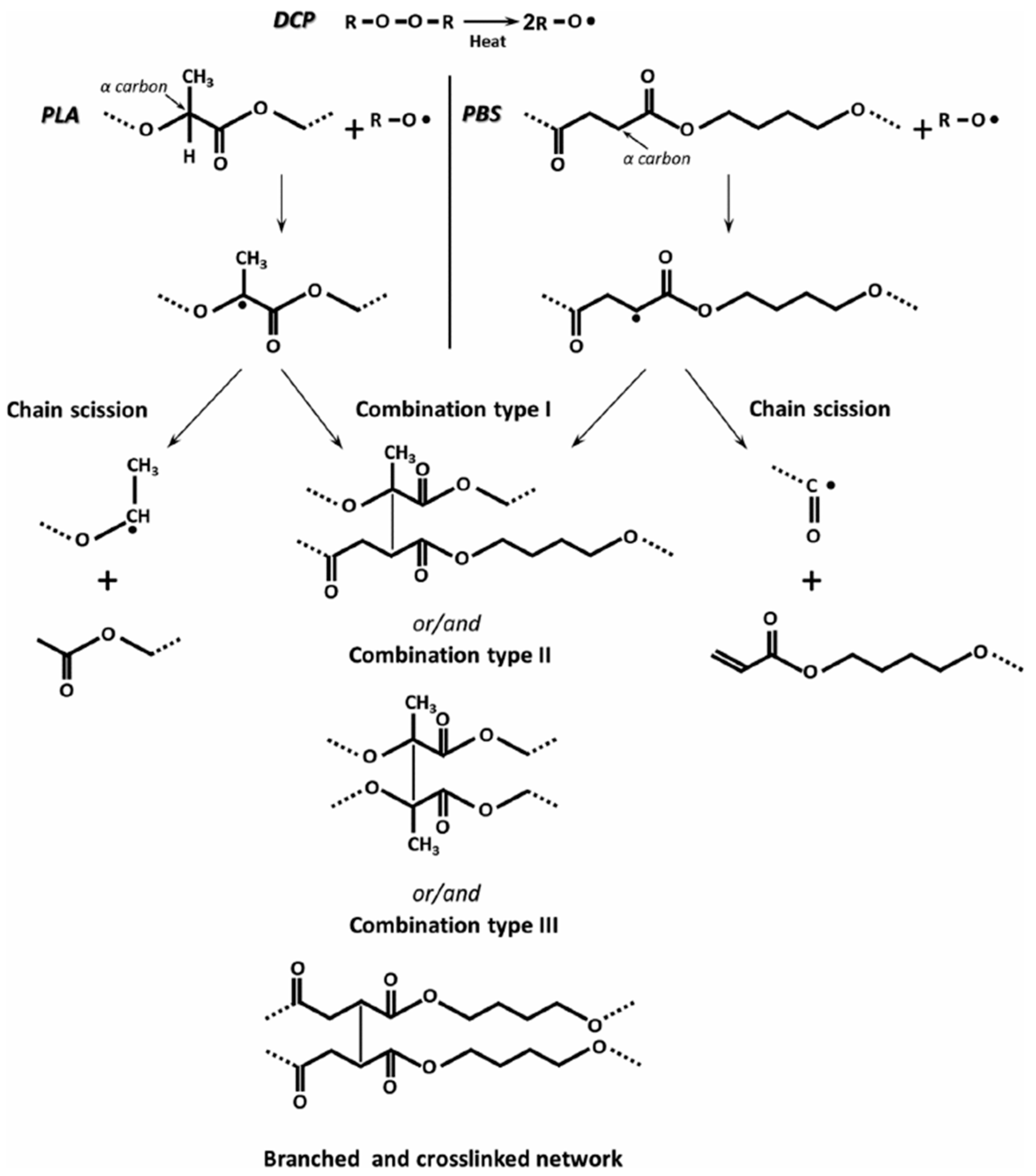
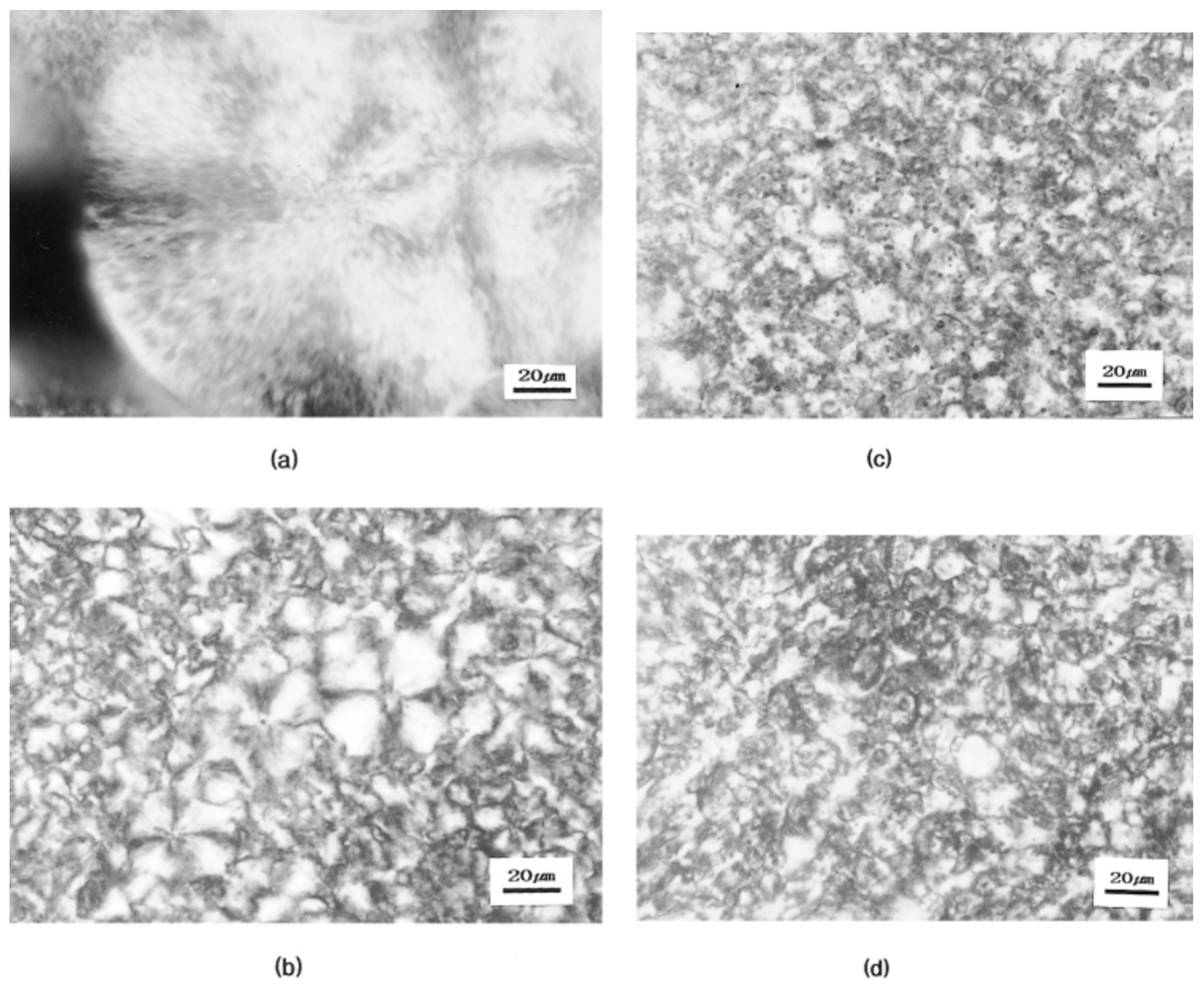
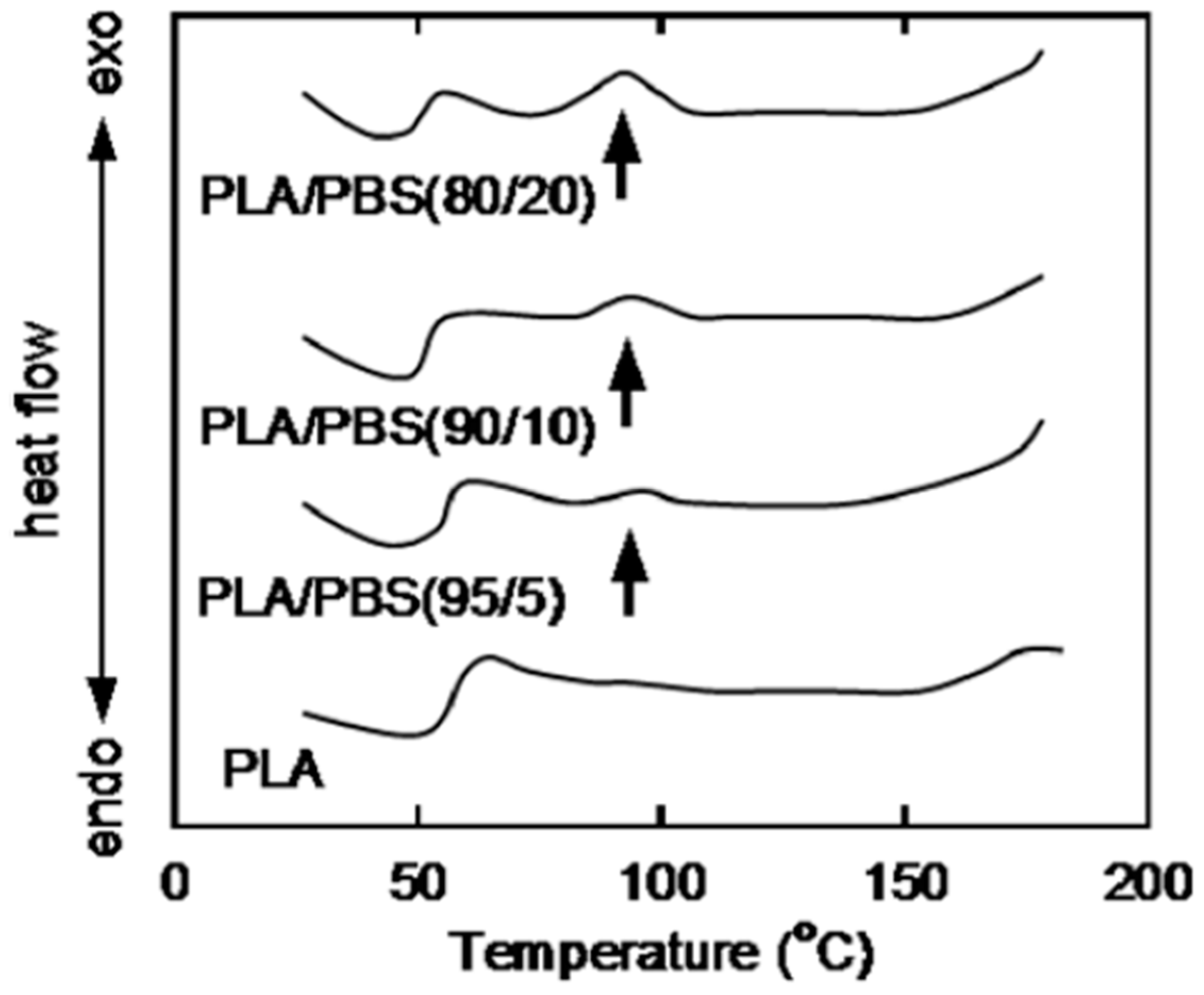
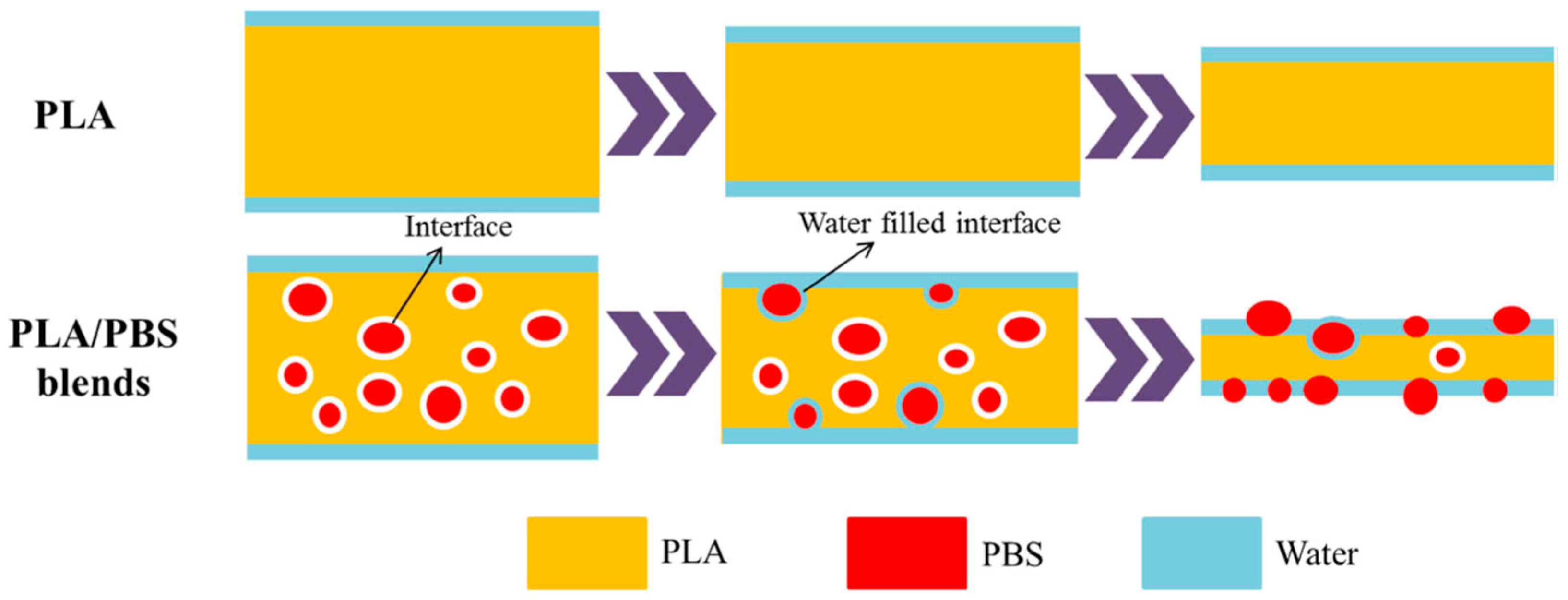
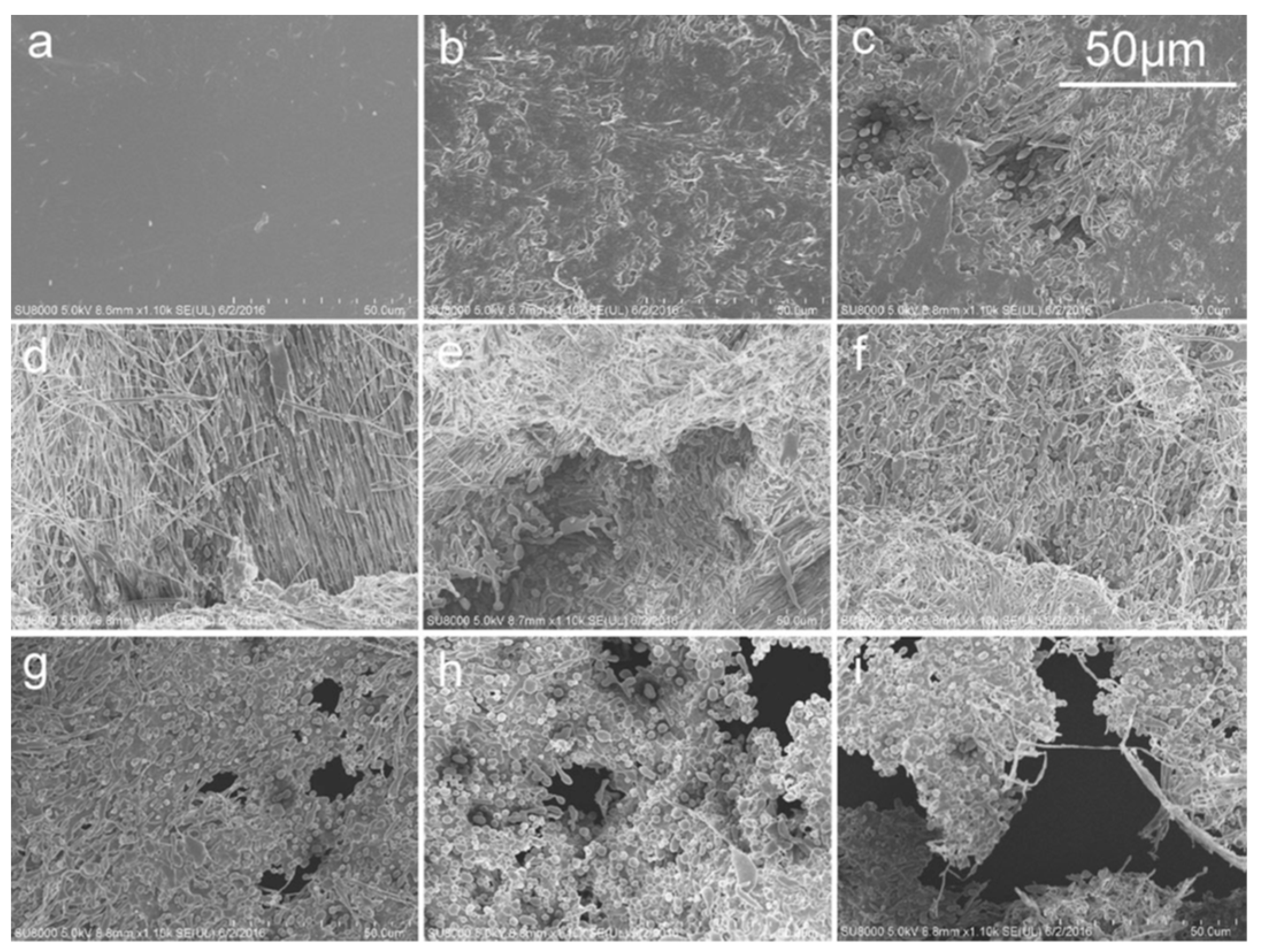
| Property | PLA | PBS |
|---|---|---|
| Glass transition temperature [°C] | 55–60 | −32 |
| Melting point * [°C] | 150–175 | 114 |
| Heat distortion temperature [°C] | 55 | 97 |
| Modulus of elasticity [MPa] | 3500–4150 | 550–700 |
| Tensile strength [MPa] | 50–70 | 34 |
| Elongation at break [%] | 4–7 | 560 |
| Derived from renewable raw materials | Yes | Partly |
| Biodegradable at 70 °C | Yes | Yes |
| Biodegradable at 30 °C | No | Yes |
| Method | Ratio PLA/PBS | Modifier | Ratio Polymer/Modifier | Test Specimen | Morphology, Crystallization, and Mechanical Properties | Ref |
|---|---|---|---|---|---|---|
| Plasticiz. | 80/20 | Isosorbide diester (ISE) | 100:15 | Extruded flat films, 180–205 °C, 787 rpm, thickness: 20–50 µm | Porous structure ↓; presence of holes and defects ↓; cold crystalliz. temp.↓ for 21 °C; Tg ↓ from 55.3 to 34.7 °C; elongation at break: 250%. MOE: 511 MPa; TS: 19.8 MPa. | [41] |
| Plasticiz. | 80/20 | Poly (ethylene glycol) (PEG) | 100:10 | Injection-molded dumbbell at 220 °C, thickness: 3 mm | Tg of PLA ↓ significantly, crystallization rate of PLA ↓, elongation at break ↑ slightly. | [36] |
| Reactive compat. | 90/10 | Lysine triisocyanate (LTI) | 100:0.5 | Injection-molded samples at 220 °C, mold: 30 °C, 40–60 MPa, *1 | Particle number ↑; particle size ↓; elongation at break ↑ to >150%. impact strength ↑ 3-fold than that of PLA. | [42] |
| Reactive compat. | 80/20 | Benzoyl peroxide (BPO) | 100:1 | Hot-pressed sheets, at 160 °C, 3 min, then cold-pressed at room temperature, thickness: 0.5 mm | No phase separation; smooth surface; crystallinity ↓ due to cross-linking; elongation at break ↑ to about 400%, TS: little change. | [43] |
| Reactive compat. | 80/20 | Dicumyl peroxide (DCP) | 100:0.3 | Pressed tensile bars, at 180 °C, 10 MPa, thickness: 0.6 mm | PBS domain size ↓; isothermal crystallization time ↓; TS ↑ from 55 to 80 MPa, elongation at break ↑ from 49 to 205%. | [48] |
| Reactive compat. | 80/20 | Dicumyl peroxide (DCP) | 100:0.2 | Injection-molded specimens, cylinder 170–200 °C, die: 195 °C, mold: 25 °C, *1 | PBS domain size ↓; improved dispersion of PBS in PLA matrix; TS & MOE slightly ↑; elongation at break ↑ >400%. | [44] |
| Reactive compat. | 80/20 | Dicumyl peroxide (DCP) | 100:0.1 | Compression-molded sheets, thickness: 1 mm, at 170 °C, 8 min | PBS domain size ↓; uniform morphology; no nucleating effect on PLLA; elongation at break (250%): no change; impact strength ↑ for 8 times. | [16] |
| Reactive compat. | 70/30 | Methylene diphenyl diisocyanate (MDI) | 100:5 | Compression-molded tensile bars, at 180 °C, mold: 50 °C, 5 MPa, *1 | Morphology: uniform, no cavities or obvious phase separation TS & MOE ↓ slightly; elongation at break ↑ to 285%. | [46] |
| Reactive compat. | 75/25 | Twice functionalized organoclay (TFC) with epoxy groups | 100:2 | Hot pressed specimens: 10 mm × 50 mm × 1 mm | PBS domain size ↓ from 1.8 to 0.59 µm, when TFC at 2 phr; tensile modulus ↑ from 1075 to 1407 MPa; elongation at break ↑ from 72 to 76%. | [49] |
| Reactive compat. | 50/50 | Glycidyl methacrylate (GMA) | 100:10 | Compression-molded sheets, 0.25 mm thick, 120 bar, 140–190 °C | Fibril formation before tensile fracture of the sheets; miscibility ↑; crystallinity ↓ due to crosslinking; elongation at break ↑ >4000 times. | [47] |
| Copolym. | 80/20 | Random copolymer rPBSL | 100:5 | Blown film, thickness: 40 µm, extruder: 100–175 °C, 80–100 rpm | Smooth surface without droplets; Tg ↓ from 52 to 43 °C; Tc ↓ from 103 to 85 °C; crystallinity ↑ from 22 to 34%; spherulite growth rate ↑; elongation at break ↑ for 4 times. | [23] |
| Copolym. | 80/20 | Linear block copolymer PLLA40-b-PBS28-b-PLLA40 | 100:3 | Compression-molded film, thickness: 40 µm | Smooth surface; formation of uniform spherulites; isothermal crystallization ↑; Transmittance (clarity) ↑; Tg ↓ to 20 °C; elongation at break ↑ for 2-fold. | [37] |
| Copolym. | 70/30 | Linear block copolymer PLLA37.5-b-PBS25-b-PLLA37.5 | 100:20 | Compression-molded sheets, at 180 °C, 10 MPa, thickness: 1 mm | PBS domain size ↓; elongation at break ↑ from 26% to 75%. | [45] |
| Copolym. | 70/30 | 3-arm block copolymer (PLLA-b- PGMA)3 | 100:2 | Compression-molded sheets at 180 °C, 10 MPa, thickness: 1 mm | PBS domain size ↓; uniform surface; cavities almost disappeared; elongation at break ↑ from 26% to 85%. | [45] |
| Copolym. | 70/30 | Linear block copolymer + branched copolymer | 100:20:2 | Compression-molded sheets, at 180 °C, 10 MPa, thickness: 1 mm | No obvious phase separation, uneven fracture surface; elongation at break ↑ up to 250%. | [45] |
| Method | Ratio PLA/PBS | Modifier | Ratio Polymer/Modifier | Test Specimen | Morphology, Crystallization, and Mechanical Properties | Ref |
|---|---|---|---|---|---|---|
| Stereo-com. | 100/0 | PLLA70-mb-PBS30 multiblock copolymer for PDLA-matrix | 47:53 | Solution-blending and drying; casting on petri-dishes | Negative 3-dimensional spherulites in SEM; a single Tg (−19 °C): miscibility ↑; enhanced Tm = 192.9 °C at 2nd heating; crystallization rate ↑. | [14] |
| Nucleat. | 60/40 | Talc with an average particle size of 1 µm | 100:5 | Casting on petri-dishes; solvent (chloroform) was removed in oven at 80 °C, 24 h | 120 °C: spherulite size ↓ as talc [%] ↑. 90 °C: spherulite size ↑ as talc [%] ↑. Crystallization rate ↑ at 95 °C, 110 °C, and 120 °C in isothermal crystallization. | [54] |
| Reactive compat. + Nucleat. | 80/20 | Dicumyl peroxide (DCP) | 100:0.3 | Hot and then cold pressed tensile bars, at 180 °C, 10 MPa, thickness: 0.6 mm | PBS domain size ↓; total isothermal crystallization time ↓; TS ↑ from 55 to 80 MPa; elongation at break ↑ from 49 to 205%. | [48] |
| Reactive compat. + Nucleat. | 70/30 | Microcrystalline cellulose; epoxides (JoncrylTM) | 100:5:0.5 | Hot pressed sheets: thickness: 1 mm and 3 mm, at 180 °C, 7 min | Better miscibility in SEM; no Tcc of PBS in blend; MCC promotes PBS crystallization; impact strength ↑ from 6 to 13 KJ/m2; elongation at break ↓. | [24] |
| Reactive compat. + Nucleat. | 67/33 | EJ400 + LAK 301 (aromatic sulfonate derivate) | (90:10):3 | Blown film, blow-up ratio: 4.75; 140–190 °C, 200 rpm; thickness: 40 µm | Nucleating agent agglomerates; crystallinity of PLA ↑ by LAK; when LAK content ↑: more isotropy of films (MD/CD) in tensile test; tear resistance ↑. | [17] |
| (Draft) Standard | Title |
|---|---|
| prEN ISO 14851:2016 | Determination of the ultimate aerobic biodegradability of plastic materials in an aqueous medium—method by measuring the oxygen demand in a closed respirometer |
| prEN ISO 14852:2017 | Determination of the ultimate aerobic biodegradability of plastic materials in an aqueous medium—method by analysis of evolved carbon dioxide |
| EN ISO 14855-1:2012 | Determination of the ultimate aerobic biodegradability of plastic materials under controlled composting conditions—method by analysis of evolved carbon dioxide—Part 1: General method |
| prEN ISO 14855-2:2017 | Determination of the ultimate aerobic biodegradability of plastic materials under controlled composting conditions—method by analysis of evolved carbon dioxide—Part 2: Gravimetric measurement of carbon dioxide evolved in a laboratory-scale test |
| EN 17033:2018 | Plastics—Biodegradable mulch films for use in agriculture and horticulture—Requirements and test methods |
| prEN ISO 17556:2018 | Plastics—Determination of the ultimate aerobic biodegradability of plastic materials in soil by measuring the oxygen demand in a respirometer or the amount of carbon dioxide evolved |
| EN ISO 20200:2015 | Plastics—Determination of the degree of disintegration of plastic materials under simulated composting conditions in a laboratory-scale test |
| ISO 16929:2013-04 | Plastics—Determination of the degree of disintegration of plastic materials under defined composting conditions in a pilot-scale test |
| Polymer | PLA | PBS |
|---|---|---|
| Type | Chemical hydrolysis | Enzymatic hydrolysis |
| Access point | Outer to inner | Outer only |
| Surface appearance | Smooth (not eroded) | Rough (eroded) |
| Weight loss | Negligible | Detectable |
| Molecular weight reduction | Detectable | Negligible |
| Type | Ratio PLA/PBS | Test Specimen | Degradation Conditions | Degradation Outcomes | Ref |
|---|---|---|---|---|---|
| Disintegration in composting conditions | 80/20 | Films prepared by solvent casting: 15 × 15 × 0.03 mm3 | 4–6 cm depth in boxes with soil: aerobic, 58 °C, 50% RH, 17 days | The disintegration value is reduced as a consequence of higher crystalline nature induced by PBS; surfactant facilitates the disintegration. degree of disintegration >90%, 17 days. | [53] |
| Enzymatic degradation | 80/20/1 (BPO) | Films 30 × 10 × 0.1 mm3 | Incubation: 37 °C, in buffer (pH = 8), proteinase K | Filaments appear on the surface; films became thin; randomly distributed holes form into large ones; degradation rate: 67%, 96 h. | [43] |
| Hydrolytic degradation (Soil burial test) | 80/20 etc. | Compression-molded sheets: at 180 °C, 12 MPa, 0.3 mm thick. | Soil temp.: 29–39 °C; soil moisture: 18–30%, 60 days | Blends with higher content of PBS have higher rate of biodegradation; Mn decreases as a function of degradation time. | [66] |
| Hydrolytic degradation (NaOH solution) | 70/30 | Compression-molded sheets (at 190 °C, 5 MPa, 50 µm thick) | Incubation: 37 °C, NaOH, pH = 13 | Immiscible PBS particles induce gaps in blends, providing channels for water penetration; hydrolytic degradation ↑; weight loss per unit area ↑ when PBS content ↑. | [35] |
© 2019 by the authors. Licensee MDPI, Basel, Switzerland. This article is an open access article distributed under the terms and conditions of the Creative Commons Attribution (CC BY) license (http://creativecommons.org/licenses/by/4.0/).
Share and Cite
Su, S.; Kopitzky, R.; Tolga, S.; Kabasci, S. Polylactide (PLA) and Its Blends with Poly(butylene succinate) (PBS): A Brief Review. Polymers 2019, 11, 1193. https://doi.org/10.3390/polym11071193
Su S, Kopitzky R, Tolga S, Kabasci S. Polylactide (PLA) and Its Blends with Poly(butylene succinate) (PBS): A Brief Review. Polymers. 2019; 11(7):1193. https://doi.org/10.3390/polym11071193
Chicago/Turabian StyleSu, Shen, Rodion Kopitzky, Sengül Tolga, and Stephan Kabasci. 2019. "Polylactide (PLA) and Its Blends with Poly(butylene succinate) (PBS): A Brief Review" Polymers 11, no. 7: 1193. https://doi.org/10.3390/polym11071193
APA StyleSu, S., Kopitzky, R., Tolga, S., & Kabasci, S. (2019). Polylactide (PLA) and Its Blends with Poly(butylene succinate) (PBS): A Brief Review. Polymers, 11(7), 1193. https://doi.org/10.3390/polym11071193







